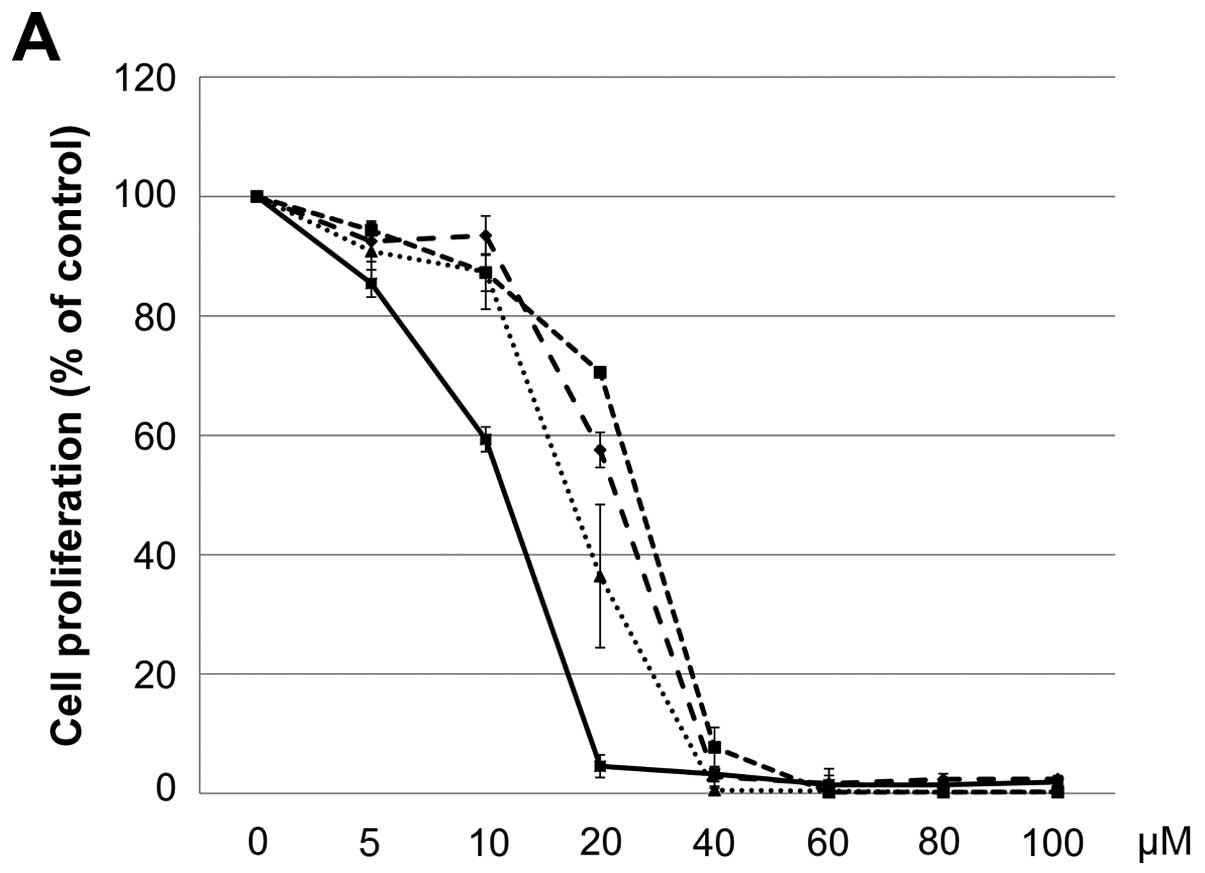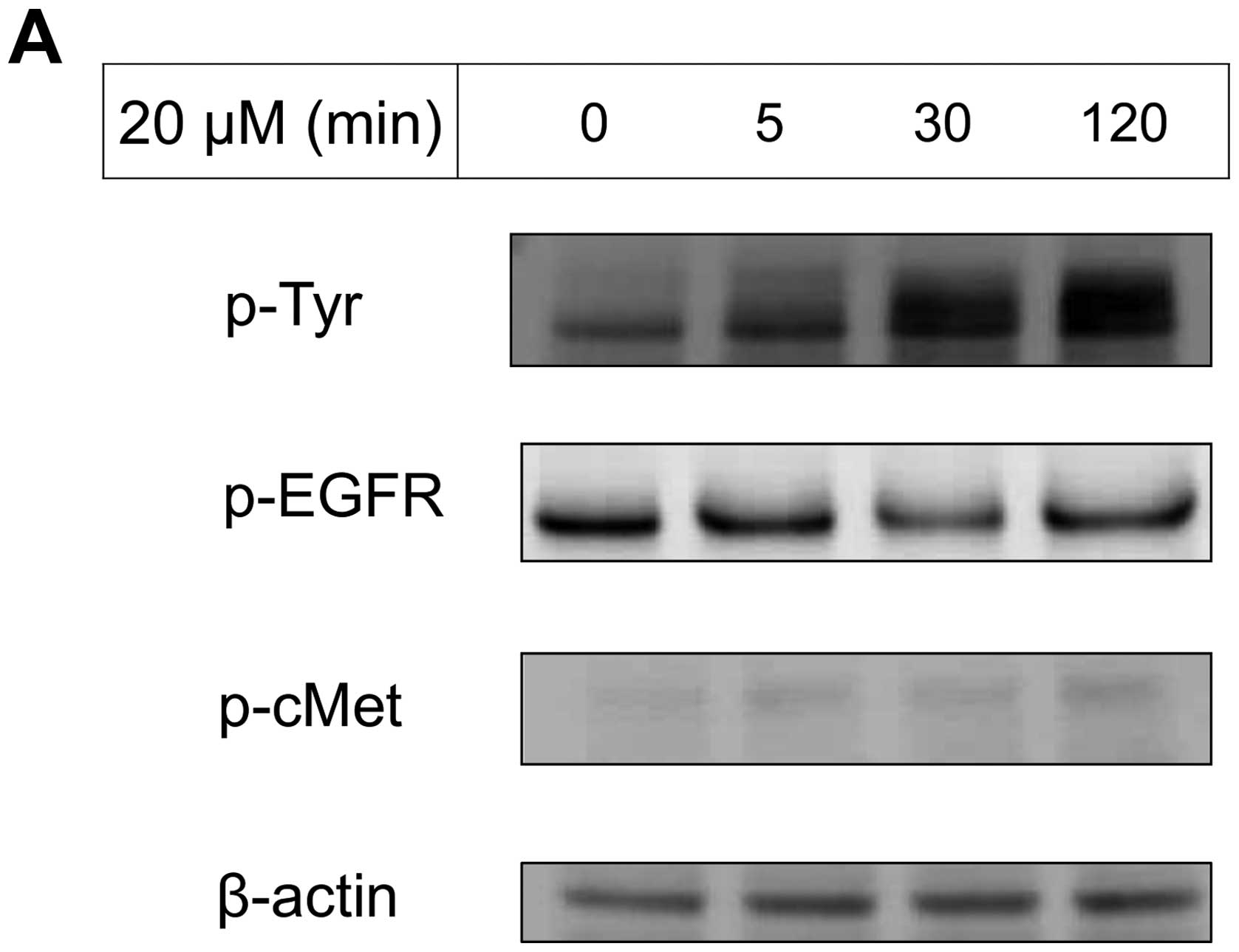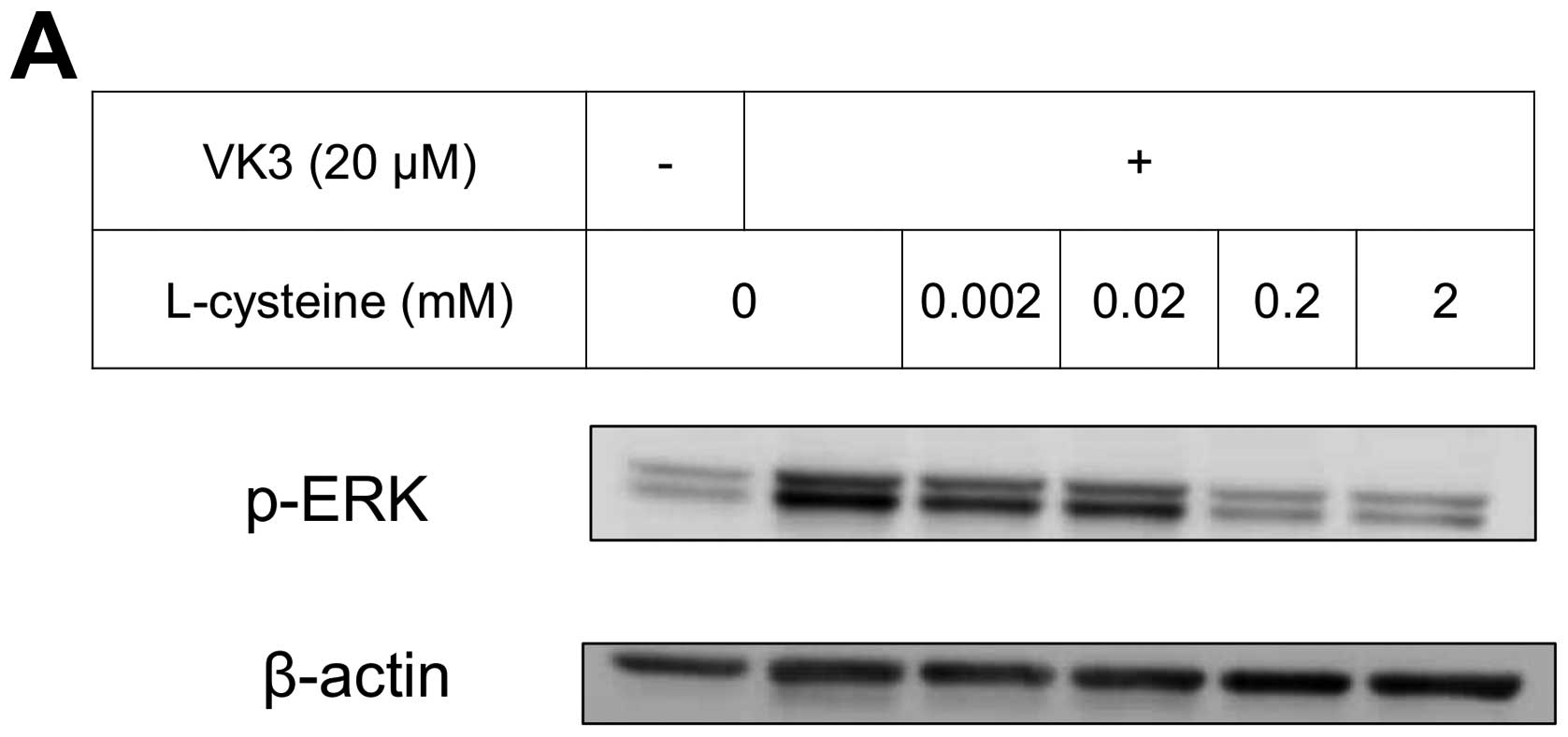|
1
|
Jemal A, Bray F, Center MM, Ferlay J, Ward
E and Forman D: Global cancer statistics. CA Cancer J Clin.
61:69–90. 2011. View Article : Google Scholar : PubMed/NCBI
|
|
2
|
Williams C and Lin CY: Oestrogen receptors
in breast cancer: Basic mechanisms and clinical implications. E
Cancer Medical Sci. 7:3702013.
|
|
3
|
Oostra DR and Macrae ER: Role of
trastuzumab emtansine in the treatment of HER2-positive breast
cancer. Breast Cancer (Dove Med Press). 6:103–113. 2014.
|
|
4
|
Zelnak AB and Wisinski KB: Management of
patients with HER2-positive metastatic breast cancer: Is there an
optimal sequence of HER2-directed approaches? Cancer. 121:17–24.
2015. View Article : Google Scholar
|
|
5
|
Abramson VG, Lehmann BD, Ballinger TJ and
Pietenpol JA: Subtyping of triple-negative breast cancer:
Implications for therapy. Cancer. 121:8–16. 2015. View Article : Google Scholar
|
|
6
|
O’Toole SA, Beith JM, Millar EK, West R,
McLean A, Cazet A, Swarbrick A and Oakes SR: Therapeutic targets in
triple negative breast cancer. J Clin Pathol. 66:530–542. 2013.
View Article : Google Scholar
|
|
7
|
Dent R, Trudeau M, Pritchard KI, Hanna WM,
Kahn HK, Sawka CA, Lickley LA, Rawlinson E, Sun P and Narod SA:
Triple-negative breast cancer: Clinical features and patterns of
recurrence. Clin Cancer Res. 13:4429–4434. 2007. View Article : Google Scholar : PubMed/NCBI
|
|
8
|
Liedtke C, Mazouni C, Hess KR, André F,
Tordai A, Mejia JA, Symmans WF, Gonzalez-Angulo AM, Hennessy B,
Green M, et al: Response to neoadjuvant therapy and long-term
survival in patients with triple-negative breast cancer. J Clin
Oncol. 26:1275–1281. 2008. View Article : Google Scholar : PubMed/NCBI
|
|
9
|
Lehmann BD, Bauer JA, Chen X, Sanders ME,
Chakravarthy AB, Shyr Y and Pietenpol JA: Identification of human
triple-negative breast cancer subtypes and preclinical models for
selection of targeted therapies. J Clin Invest. 121:2750–2767.
2011. View
Article : Google Scholar : PubMed/NCBI
|
|
10
|
Tsimberidou AM, Iskander NG, Hong DS,
Wheler JJ, Falchook GS, Fu S, Piha-Paul S, Naing A, Janku F, Luthra
R, et al: Personalized medicine in a phase I clinical trials
program: The MD Anderson Cancer Center initiative. Clin Cancer Res.
18:6373–6383. 2012. View Article : Google Scholar : PubMed/NCBI
|
|
11
|
Gelmon K, Dent R, Mackey JR, Laing K,
McLeod D and Verma S: Targeting triple-negative breast cancer:
Optimising therapeutic outcomes. Ann Oncol. 23:2223–2234. 2012.
View Article : Google Scholar : PubMed/NCBI
|
|
12
|
Nguyen T, Hattery E and Khatri VP:
Radiofrequency ablation and breast cancer: A review. Gland Surg.
3:128–135. 2014.PubMed/NCBI
|
|
13
|
Hamza A and Elrefaey S: Non-surgical
treatment of early breast cancer: Techniques on the way. Gland
Surg. 3:149–150. 2014.PubMed/NCBI
|
|
14
|
Manenti G, Scarano AL, Pistolese CA,
Perretta T, Bonanno E, Orlandi A and Simonetti G: Subclinical
breast cancer: Minimally invasive approaches Our experience with
percutaneous radiofrequency ablation vs cryotherapy. Breast Care
(Basel). 8:356–360. 2013. View Article : Google Scholar
|
|
15
|
Zagar TM, Vujaskovic Z, Formenti S, Rugo
H, Muggia F, O’Connor B, Myerson R, Stauffer P, Hsu I-C, Diederich
C, et al: Two phase I dose-escalation/pharmacokinetics studies of
low temperature liposomal doxorubicin (LTLD) and mild local
hyperthermia in heavily pretreated patients with local regionally
recurrent breast cancer. Int J Hyperthermia. 30:285–294. 2014.
View Article : Google Scholar : PubMed/NCBI
|
|
16
|
Kovacic P and Jacintho JD: Mechanisms of
carcinogenesis: Focus on oxidative stress and electron transfer.
Curr Med Chem. 8:773–796. 2001. View Article : Google Scholar : PubMed/NCBI
|
|
17
|
Dong-Yun S, Yu-Ru D, Shan-Lin L, Ya-Dong Z
and Lian W: Redox stress regulates cell proliferation and apoptosis
of human hepatoma through Akt protein phosphorylation. FEBS Lett.
542:60–64. 2003. View Article : Google Scholar : PubMed/NCBI
|
|
18
|
Suresh S, Raghu D and Karunagaran D:
Menadione (Vitamin K3) induces apoptosis of human oral cancer cells
and reduces their metastatic potential by modulating the expression
of epithelial to mesenchymal transition markers and inhibiting
migration. Asian Pac J Cancer Prev. 14:5461–5465. 2013. View Article : Google Scholar : PubMed/NCBI
|
|
19
|
Baran I, Ionescu D, Filippi A, Mocanu MM,
Iftime A, Babes R, Tofolean IT, Irimia R, Goicea A, Popescu V, et
al: Novel insights into the antiproliferative effects and synergism
of quercetin and menadione in human leukemia Jurkat T cells. Leuk
Res. 38:836–849. 2014. View Article : Google Scholar : PubMed/NCBI
|
|
20
|
Margolin KA, Akman SA, Leong LA, Morgan
RJ, Somlo G, Raschko JW, Ahn C and Doroshow JH: Phase I study of
mitomycin C and menadione in advanced solid tumors. Cancer
Chemother Pharmacol. 36:293–298. 1995. View Article : Google Scholar : PubMed/NCBI
|
|
21
|
Tetef M, Margolin K, Ahn C, Akman S, Chow
W, Leong L, Morgan RJ Jr, Raschko J, Somlo G and Doroshow JH:
Mitomycin C and menadione for the treatment of lung cancer: A phase
II trial. Invest New Drugs. 13:157–162. 1995. View Article : Google Scholar : PubMed/NCBI
|
|
22
|
Tetef M, Margolin K, Ahn C, Akman S, Chow
W, Coluzzi P, Leong L, Morgan RJ Jr, Raschko J, Shibata S, et al:
Mitomycin C and menadione for the treatment of advanced
gastrointestinal cancers: A phase II trial. J Cancer Res Clin
Oncol. 121:103–106. 1995. View Article : Google Scholar : PubMed/NCBI
|
|
23
|
Osada S, Tomita H, Tanaka Y, Tokuyama Y,
Tanaka H, Sakashita F and Takahashi T: The utility of vitamin K3
(menadione) against pancreatic cancer. Anticancer Res. 28A:45–50.
2008.
|
|
24
|
Osada S, Sakashita F, Hosono Y, Nonaka K,
Tokuyama Y, Tanaka H, Sasaki Y, Tomita H, Komori S, Matsui S, et
al: Extracellular signal-regulated kinase phosphorylation due to
menadione-induced arylation mediates growth inhibition of pancreas
cancer cells. Cancer Chemother Pharmacol. 62:315–320. 2008.
View Article : Google Scholar
|
|
25
|
Osada S and Carr BI: Mechanism of novel
vitamin K analog induced growth inhibition in human hepatoma cell
line. J Hepatol. 34:676–682. 2001. View Article : Google Scholar : PubMed/NCBI
|
|
26
|
Osada S, Saji S and Osada K: Critical role
of extracellular signal-regulated kinase phosphorylation on
menadione (vitamin K3) induced growth inhibition. Cancer.
91:1156–1165. 2001. View Article : Google Scholar : PubMed/NCBI
|
|
27
|
Osada S, Osada K and Carr BI: Tumor cell
growth inhibition and extracellular signal-regulated kinase (ERK)
phosphorylation by novel K vitamins. J Mol Biol. 314:765–772. 2001.
View Article : Google Scholar : PubMed/NCBI
|
|
28
|
Imai H, Saio M, Nonaka K, Suwa T, Umemura
N, Ouyang GF, Nakagawa J, Tomita H, Osada S, Sugiyama Y, et al:
Depletion of CD4+CD25+ regulatory T cells
enhances interleukin-2-induced antitumor immunity in a mouse model
of colon adenocarcinoma. Cancer Sci. 98:416–423. 2007. View Article : Google Scholar : PubMed/NCBI
|
|
29
|
Wang S, Konorev EA, Kotamraju S, Joseph J,
Kalivendi S and Kalyanaraman B: Doxorubicin induces apoptosis in
normal and tumor cells via distinctly different mechanisms.
intermediacy of H (2) O (2)- and p53-dependent pathways. J Biol
Chem. 279:25535–25543. 2004. View Article : Google Scholar : PubMed/NCBI
|
|
30
|
Mizutani H, Tada-Oikawa S, Hiraku Y,
Oikawa S, Kojima M and Kawanishi S: Mechanism of apoptosis induced
by a new topoisomerase inhibitor through the generation of hydrogen
peroxide. J Biol Chem. 277:30684–30689. 2002. View Article : Google Scholar : PubMed/NCBI
|
|
31
|
Chen FH, Zhang LB, Qiang L, Yang Z, Wu T,
Zou MJ, Tao L, You QD, Li ZY, Yang Y, et al: Reactive oxygen
species-mitochondria pathway involved in LYG-202-induced apoptosis
in human hepatocellular carcinoma HepG (2) cells. Cancer Lett.
296:96–105. 2010. View Article : Google Scholar : PubMed/NCBI
|
|
32
|
Wu J, Chien CC, Yang LY, Huang GC, Cheng
MC, Lin CT, Shen SC and Chen YC: Vitamin K3-2, 3-epoxide induction
of apoptosis with activation of ROS-dependent ERK and JNK protein
phosphorylation in human glioma cells. Chem Biol Interact.
193:3–11. 2011. View Article : Google Scholar : PubMed/NCBI
|
|
33
|
Yang CR, Liao WS, Wu YH, Murugan K, Chen C
and Chao JI: CR108, a novel vitamin K3 derivative induces apoptosis
and breast tumor inhibition by reactive oxygen species and
mitochondrial dysfunction. Toxicol Appl Pharmacol. 273:611–622.
2013. View Article : Google Scholar : PubMed/NCBI
|
|
34
|
Johnson ME and Howerth EW: Survivin: A
bifunctional inhibitor of apoptosis protein. Vet Pathol.
41:599–607. 2004. View Article : Google Scholar : PubMed/NCBI
|
|
35
|
Akiyoshi T, Matzno S, Sakai M, Okamura N
and Matsuyama K: The potential of vitamin K3 as an anticancer agent
against breast cancer that acts via the mitochondria-related
apoptotic pathway. Cancer Chemother Pharmacol. 65:143–150. 2009.
View Article : Google Scholar : PubMed/NCBI
|
|
36
|
Sasaki R, Suzuki Y, Yonezawa Y, Ota Y,
Okamoto Y, Demizu Y, Huang P, Yoshida H, Sugimura K and Mizushina
Y: DNA polymerase gamma inhibition by vitamin K3 induces
mitochondria-mediated cytotoxicity in human cancer cells. Cancer
Sci. 99:1040–1048. 2008. View Article : Google Scholar : PubMed/NCBI
|
|
37
|
Li X, Wang K, Ren Y, Zhang L, Tang XJ,
Zhang HM, Zhao CQ, Liu PJ, Zhang JM and He JJ: MAPK signaling
mediates sino-menine hydrochloride-induced human breast cancer cell
death via both reactive oxygen species-dependent and -independent
pathways: An in vitro and in vivo study. Cell Death Dis.
5:e13562014. View Article : Google Scholar
|
|
38
|
Cagnol S and Chambard JC: ERK and cell
death: Mechanisms of ERK-induced cell death - apoptosis, autophagy
and senescence. FEBS J. 277:2–21. 2010. View Article : Google Scholar
|
|
39
|
Osada S and Yoshida K: A novel strategy
for advanced pancreatic cancer - progression of molecular targeting
therapy. Anticancer Agents Med Chem. 9:877–881. 2009. View Article : Google Scholar : PubMed/NCBI
|
|
40
|
Osada S and Saji S: New approach to cancer
therapy: The application of signal transduction to anti-cancer
drug. Curr Med Chem Anticancer Agents. 3:119–131. 2003. View Article : Google Scholar : PubMed/NCBI
|
|
41
|
Esakky P, Hansen DA, Drury AM and Moley
KH: Cigarette smoke-induced cell cycle arrest in spermatocytes
[GC-2spd (ts)] is mediated through crosstalk between Ahr-Nrf2
pathway and MAPK signaling. J Mol Cell Biol. 7:73–87. 2015.
View Article : Google Scholar
|
|
42
|
Shah M, Stebbins JL, Dewing A, Qi J,
Pellecchia M and Ronai ZA: Inhibition of Siah2 ubiquitin ligase by
vitamin K3 (menadione) attenuates hypoxia and MAPK signaling and
blocks melanoma tumorigenesis. Pigment Cell Melanoma Res.
22:799–808. 2009. View Article : Google Scholar : PubMed/NCBI
|
|
43
|
Scott GK, Atsriku C, Kaminker P, Held J,
Gibson B, Baldwin MA and Benz CC: Vitamin K3 (menadione)-induced
oncosis associated with keratin 8 phosphorylation and histone H3
arylation. Mol Pharmacol. 68:606–615. 2005.PubMed/NCBI
|
|
44
|
Osada S, Kanematsu M, Imai H, Goshima S
and Sugiyama Y: Evaluation of extracellular signal regulated kinase
expression and its relation to treatment of hepatocellular
carcinoma. J Am Coll Surg. 201:405–411. 2005. View Article : Google Scholar : PubMed/NCBI
|















